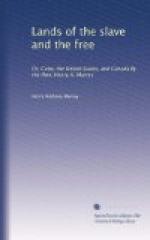This charming lake has comparatively little cultivation on its borders; two or three cottages, and a few cattle grazing, are the only signs that man is asserting his dominion over the wilderness. One of these cottages belongs to a member of the Wadsworth family, who owns some extent of land in the neighbourhood, and who has built a nice little boat for sailing about in the summer season. I may as well mention in this place, that the roofing generally used for cottages is a wooden tile called “shingle,” which is very cheap—twelve-and-sixpence purchasing enough to cover a thousand feet.
While driving about in this neighbourhood, I saw, for the first time, what is termed a “plank-road,”—a system which has been introduced into the United States from Canada. The method of construction is very simple, consisting of two stringers of oak two inches square, across which are laid three-inch planks eight feet long, and generally of hemlock or pine. No spiking of the planks into the stringers is required, and a thin layer of sand or soil being placed over all, the road is made; and, as the material for construction is carried along as the work progresses, the rapidity of execution is astonishing. When completed, it is as smooth as a bowling-green. The only objection I ever heard to these roads is, that the jarring sensation produced by them is very injurious to the horses’ legs; but it can hardly be thought that, if the cart were up to the axle and the horse up to the belly-band in a good clay soil, any advantage would be derived from such a primitive state of things. Taking an average, the roads may be said to last from eight to ten years, and cost about L330 a mile. Those in Canada are often made much broader, so as to enable two vehicles to pass abreast, and their cost is a little above L400 a mile. The toll here is about three-farthings a mile per horse. They have had the good sense to avoid the ridiculous wheel-tollage to which we adhere at home with a tenacity only equalled by its folly, as if a two-wheeled cart, with a ton weight of cargo, drawn by a Barclay and Perkinser, did not cut up a road much more than the little four-wheel carriage of the clergyman’s wife, drawn by a cob pony, and laden with a tin of soup or a piece of flannel for some suffering parishioner. But as




